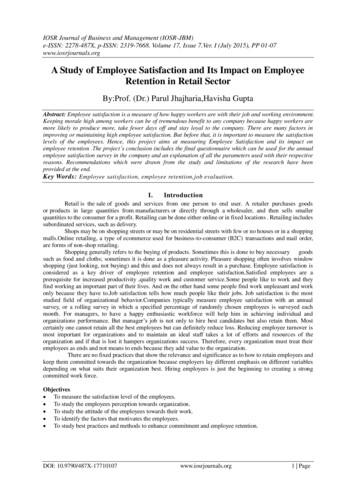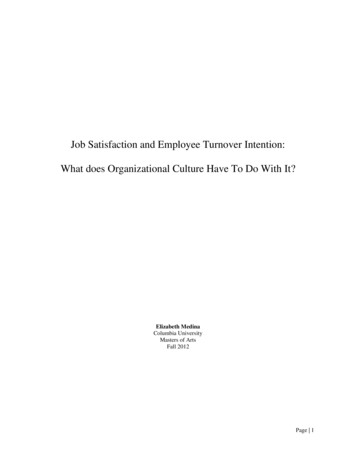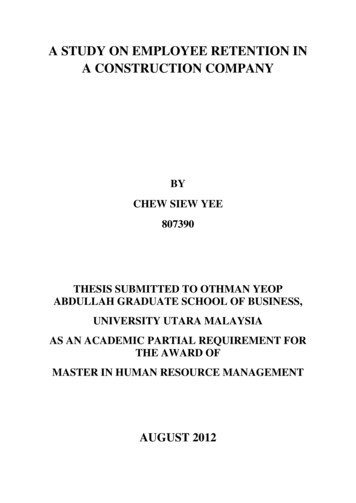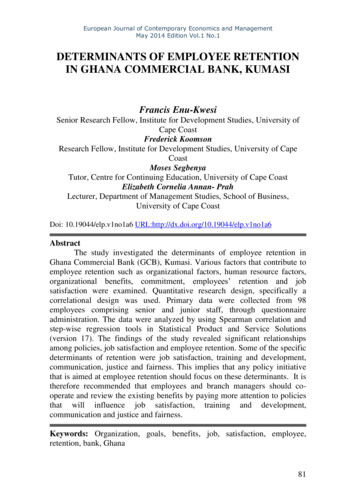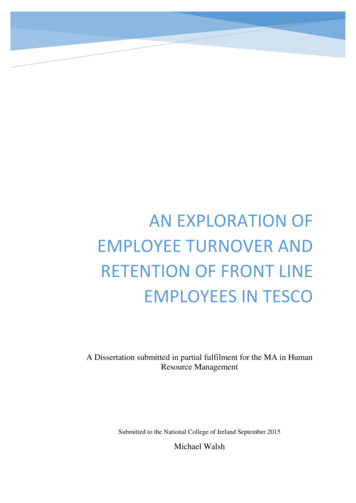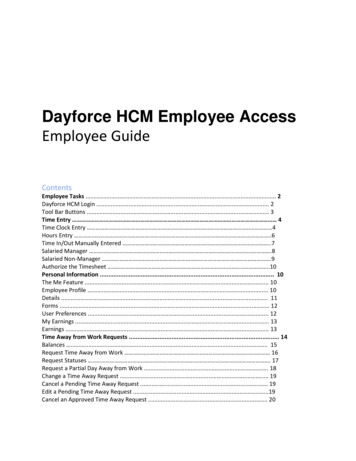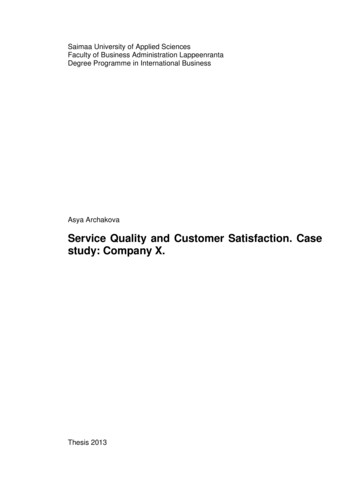
Transcription
Magnus Kindberg, Hampus Olsson, Bawan SaeidSatisfaction on employee retention- A quantitative researchAuthors:Kindberg, MagnusOlsson, HampusSaeid, BawanSupervisor: Sandell, MichaelaExaminer: Devine, ÅsaLevel: BachelorSubject: Relationship MarketingCourse: 2FE21ESemester: Spring 2016Date: 2016-05-27
Magnus Kindberg, Hampus Olsson, Bawan Saeidii
Magnus Kindberg, Hampus Olsson, Bawan Saeid“What happens if we invest in developing our employees and they leave us?”“What happens if we don’t and they stay?”- Unknown.iii
Magnus Kindberg, Hampus Olsson, Bawan SaeidAcknowledgementThis research was performed as our bachelor thesis and was conducted during the spring 2016at Linnaeus University for the Marketing Programme in Växjö, Sweden. The authors havealways had a big interest in relationship marketing and decided to write about employeeretention, as it was discussed how frequently employees switch jobs. Conducting this researchhas been a valuable experience and it has involved a lot of coffee, stress and more coffee.We would like to direct our gratefulness to Michaela Sandell who has believed in us, evenwhen times have been tough. Thank you Michaela for guidance, quick email responses andfor always keeping your door open for us. We would also like to give thanks to Åsa Devinefor constructive feedback. It has been out of great value to us and we truly appreciate it.Växjö, Sweden, 2016-05-27Magnus KindbergHampus OlssonBawan Saeidiv
Magnus Kindberg, Hampus Olsson, Bawan SaeidAbstractCourse/level: 2FE21E, Undergraduate bachelor thesis.Authors: Magnus Kindberg, Hampus Olsson, Bawan SaeidSupervisor: Michaela SandellExaminer: Åsa DevineTitle: Satisfaction on employee retention – a quantitative researchKeywords: Satisfaction, employee retention, employee empowerment, employeeengagement, employee branding, organizational structure, autonomy, goal setting, feedback,knowledge of values, motivation, employee turnover.Background: Employee retention is a theory about retaining employees. An organizationwith a high employee turnover may have trouble with increased costs in the form of hiringnew employees and replacement costs, given that their employees are leaving by choice.Employees are seen as a company’s most important assets since they are the ones deliveringvalue and satisfaction to the customers, and should therefore be treated accordingly. Previousstudies have focused on attracting new employees, however, keeping the employees withinthe company for the long run is equally as essential for the success of a business.Purpose: The purpose of this paper is to explain the relationship of satisfaction, towardsemployee retention.Hypotheses:H1: There is a positive relationship between employee empowerment and employee retention.H2: There is a positive relationship between employee engagement and employee retentionH3: There is a positive relationship between employee branding and employee retentionMethodology: This research had an explanatory approach, where a cross-sectional researchdesign was used. Furthermore, an online self-completion questionnaire was conducted.Conclusion: Based on this research, it was proven that employee engagement and employeebranding had a positive relationship towards employee retention.v
Magnus Kindberg, Hampus Olsson, Bawan Saeidvi
Magnus Kindberg, Hampus Olsson, Bawan SaeidTable of content1.0 Introduction . 11.1 Background . 11.2 Problem discussion . 21.3 Purpose . 42.0 Theoretical Framework . 52.1 Employee retention . 52.2 Employee empowerment . 62.2.1 Organizational structure.62.2.2 Autonomy .72.3 Employee engagement . 72.3.1 Goal setting .82.3.2 Feedback .92.3.3 Organizational Justice .92.4 Employee branding . 102.4.1 Knowledge of values . 112.4.2 Motivation . 113. Hypotheses and conceptual model . 133.1 The relationship between employee empowerment and employee retention . 133.2 The relationship between employee engagement and employee retention. 133.3 The relationship between employee branding and employee retention . 133.4 Conceptual model . 144. Methodology . 154.1 Research approach . 154.1.1 Inductive vs. Deductive Research . 154.1.2 Qualitative vs. Quantitative Research . 164.2 Research Design . 164.2.1 Cross sectional research design . 174.3 Data sources . 184.4 Data collection method . 184.5 Data collection instrument . 194.5.1 Operationalization and measurement of variables . 194.5.2 Self-completion questionnaire . 284.5.3 Pilot testing . 304.6 Sampling . 314.6.1 Target population . 314.6.2 Sampling frame . 324.6.3 Sample selection and data collection procedure . 334.7 Data analysis method . 334.7.1 Data coding . 344.7.2 Descriptive statistics . 344.7.3 Linear regression analysis . 354.8 Quality Criteria . 364.8.1 Content validity . 364.8.2 Construct validity. 364.8.3 Reliability . 374.9 Ethical and societal considerations . 375.0 Results . 39vii
Magnus Kindberg, Hampus Olsson, Bawan Saeid5.1 Descriptive statistics . 395.2 Quality Criteria Testing . 435.2.1 Validity . 435.2.2 Reliability . 435.3 Multiple linear regression . 445.4 Additional findings . 466.0 Discussion . 476.1 Discussion of control variables . 476.2 Discussion of hypotheses 1. 476.3 Discussion of hypotheses 2. 486.4 Discussion of hypotheses 3. 496.5 Discussion of additional findings . 517. Conclusion . 537.1 Limitations / Future suggestion . 537.2 Theoretical implications . 547.3 Managerial implications . 558.0 References . 56Appendices .
H2: There is a positive relationship between employee engagement and employee retention H3: There is a positive relationship between employee branding and employee retention Methodology: This research had an explanatory approach, where a cross-sectional research design was used. Furthermore, an online self-completion questionnaire was conducted.
